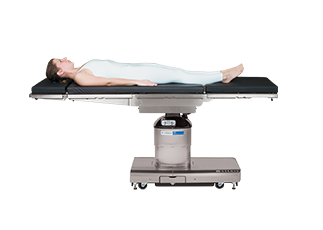Knowledge Center
January 8, 2021
The Ultimate Guide to the Supine Position

Proper patient positioning is an important part of ensuring that a surgical procedure is safe and effective. Determining a patient's position for a procedure is determined from a preoperative assessment and is based on factors like the type of procedure, length of procedure, patient’s ability to tolerate the procedure, exposure required by the surgical team, anesthesia access, among others.1 One of the four basic patient positions during surgery is the supine position.
What is the Supine Position?
The supine position is one of the four basic patient positions. The three other positions are prone, lateral, and lithotomy. In supine position, the patient is face up with their head resting on a pad positioner or pillow and their neck in a neutral position. The patient’s arms, maintained in a neutral thumb-up or supinated position, may be tucked at their sides or abducted to less than 90 degrees on armboards.2
When to Use Supine Patient Positioning
Supine patient positioning is used for intracranial procedures as well as procedures on the anterior surface of the body. Also known as Dorsal Decubitus, procedures that typically use the supine position include:
- Cardiac
- Colorectal
- Thoracic
- Abdominal
- Abdominothoracic
- Endovascular surgeries
- Laparoscopic surgeries
- Upper extremity surgeries including hand and wrist
- Lower extremity surgeries including hip, knee, foot, and ankle
Procedures on the neck and face are also often performed in supine position, as well as plastic surgeries and general surgeries.

As with all surgical positions, surgical staff should be aware of risks to the patient in the supine position.
One such risk involves the patient’s respiratory functions. When a patient is placed from an upright to a supine position, the intra-abdominal organs shift cephalad, compressing the adjacent lung tissue and potentially leading to decreased functional residual capacity (FRC).2
The supine position also causes extra pressure on the skin and bony prominences over the occiput, scapulae, elbows, sacrum, coccyx, and heels. Surgical table pads and patient positioning pads should be used to reduce the risk of pressure sores and ulcers. Additionally, the brachial plexus and ulnar nerves need to be protected in supine position by having armboards level with the operating table pad and a 90-degree extension of the arms with palms facing up.3
Benefits of the Supine Position
The supine position is one of the most natural positions for patients and usually allows for all patient anatomical structures to remain in natural neutral alignment. Most patients are able to maintain adequate respiratory function with no constricting external compression on the respiratory system. The supine position allows for excellent access to the anterior structures of the body. Also, the supine position is one of the safest positions for stability on the surgical table. It is easy to ensure that patient safety straps are placed and with the entire body supported the risk of injury from falling is further reduced.
Supine Position vs. Semi Supine Position

Semi supine position refers to positions where the patient is lying on the surgical table but with additional articulations. These are commonly referred to as:5
- Lawn chair position: A variation where the hips and knees are slightly flexed and above the level of the heart. This position can alleviate pressure on the patient's back, hips, and knees. Lawn chair position may be used to assist with relieving tension on abdominal structures and drainage from the lower extremities of venous blood.
- Frog-leg position: A variation where hips and knees are flexed, and the hips are externally rotated. This may be necessary to access anatomies such as the groin, rectum, and inner thigh. Ensure the patient's knees are supported to avoid stress on the hips.
Alternate Positions to the Supine Position
Alternate positions of the Supine position typically include tilting the patient in various planes. These position alternatives include:
- Trendelenburg position: A variation of the supine position in which the patient’s head is tilted down so that the patient’s abdominal organs are moved towards the head, improving surgical access to the pelvic organs.1,2
- Reverse Trendelenburg position: A variation of the supine position in which the patient’s head is tilted upward so that their feet are positioned down. Reverse Trendelenburg may be used for stomach, gallbladder, and biliary tract surgeries.
- Fowler’s position: This is the most common position for patient resting comfortably, whether in-patient or in the emergency department. In this position, the patient's knees are either straight or slightly bent and the head of the bed is angled between 45 and 60 degrees. Respiratory changes result in increased oxygenation by maximizing chest expansion, minimizing abdominal muscular tension, and minimizing the effects of gravity on the chest wall; therefore, a useful maneuver for patients in mild to moderate respiratory distress.
- High Fowler's position: This position, with the head of the bed between 60 and 90 degrees, is useful during the placement of orogastric and nasogastric tubes as it decreases the risk of aspiration. Also known as beach chair position, this variation of the supine position has the patient sitting with their hips and knees and slightly flexed and above heart level to relieve pressure on the back, hips, and knees. This position facilitates venous drainage from the lower extremities and reduces tension on the abdominal muscles.4 Fowler’s position is commonly used during neurosurgery and shoulder surgeries.
Conclusion
A very common patient position, the supine position allows for ideal surgical access for intracranial procedures and surgery on the anterior cervical spine.2 Surgical staff should consider risks and complications associated with the supine position such as decreased functional residual capacity and risk of pressure sores from increased pressure on the bony prominences on the patient’s body. Variations to the supine position include Trendelenburg position, reverse Trendelenburg position and Fowler’s position.
Regardless of what position is being used for a patient during a procedure, it’s important to follow best practices for positioning.1
- Having an adequate number of personnel, devices, and equipment available during positioning activities helps to ensure patient and personnel safety
- Respect the patient’s dignity and privacy during positioning. Only necessary personnel in the room with the patient is exposed.
- Maintain the patient in a natural neutral alignment. Keep the patient’s head and neck is in a neutral position without extreme lateral rotation and avoid hyperextending.
- Verify the patient's complete body is in physiologic alignment and that the hands, fingers, feet, and toes are protected from surgical table articulations.
- Operating Room staff should always use safe body mechanics during transfers and positioning.
- Ensure that the patient is not in contact with any metal portions of the surgical table or positioning devices.
- Never exceed the weight limits for the table or the accessories used and always follow the manufacture’s guidelines and recommendations when using the surgical table and accessories.
- Inspect all equipment, pads and accessories and replace them as needed.
Contributors to This Article
Lena Elias-Fogle, BSN RN, CNOR
Director, Global Clinical Solutions
Lena is a seasoned healthcare leader with extensive experience leading complex perioperative environments as well as new program development, continuous process improvement, clinical outcomes, operational excellence, and stakeholder experience.
References
1 Guideline for positioning the patient. (2017). AORN Journal, 105(4), P8-P10. doi:10.1016/s0001-2092(17)30237-5
2 Patient positioning during anesthesia: Supine position. (2016, December 20). Retrieved from http://www.clinicalpainadvisor.com/anesthesiology/patient-positioning-during-anesthesia-supine-position/article/582929
3 Rothrock, J. C. (2011). Alexander's care of the patient in surgery (14th ed.). St. Louis, MO: Mosby.
4 CBI Bookshelf. A service of the National Library of Medicine, National Institutes of Health. StatPearls [Internet]. Treasure Island (FL): StatPearls Publishing; 2020 January.
5 Armstrong M, Moore RA. Anatomy, Patient Positioning. [Updated 2020 Nov 12]. In: StatPearls [Internet]. Treasure Island (FL): StatPearls Publishing; 2020 Jan. Available from: https://www.ncbi.nlm.nih.gov/books/NBK513320/
Knowledge Center Category List
| FOLLOW US | |
|---|---|
|
|
|
|
|
|
|
|
|
|
|
|


